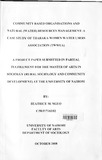| dc.contributor.author | Nguo, Beatrice M. | |
| dc.date.accessioned | 2013-04-27T08:32:08Z | |
| dc.date.available | 2013-04-27T08:32:08Z | |
| dc.date.issued | 2008 | |
| dc.identifier.citation | Master of Arts ( MA) | en |
| dc.identifier.uri | http://erepository.uonbi.ac.ke:8080/xmlui/handle/123456789/17282 | |
| dc.description.abstract | Natural resources mobilisation and management at times has not been an easy task for
communities and especially so for those living in arid and semi arid areas of Kenya.
In other cases, like in the case of Tharaka and Kanthungu locations in Mwingi
districts, communities and at times with collective responsibility with other
stakeholders have organised themselves and are managing their natural resourceswater.
In Tharaka and Kanthungu locations, a community based organisation (CBO),
Women Water User's Association (TWWUA) is managing a community water
project.
The study is an investigation of a local water management institution (TWWUA), it
characteristics and its impacts on collectively owned water resource management in
Tharaka and Kanthungu locations of Mwingi district.
The mam objective of this study was to investigate the local water management
institutions (TWWUA), it characteristics and its impacts on collectively owned water
resource management in Tharaka and Kanthungu location of Mwingi district. This
study sheds light on how water management institutions shape the individual's action
and expectations and their use of water resources and its implication on efficiency and
sustainability of the commons.
The literature review was done by review of secondary data generally on local organised institutions and on TWWUA. This information was found in different
books and journals in various libraries and at the TWWUA offices. The literature
review gives understanding on natural resources management by local institutions,
VI
collective action by members on the management and constrains that face these
institutions and the members in the management of natural resources.
Data for the study was collected from TWWUA officials, members and a few key
informants in the community. The information from TWWUA officials and members
formed the basis on the characteristics, organisation and effectiveness of the group.
More data was collected from key informants for control of the study. This data was
collected by use of questionnaires. The data which was both qualitative and
qualitative was analysed using SPSS.
Key findings and conclusions from the study were that, there was strong connection
between the management of the self-help group and its water related activities to the
empowerment of women in the Tharaka community. One of the major benefits
highlighted by both members and nonmembers as accruing from the project was the
empowerment of women in project management and general leadership with a woman
aspiring for council for the first time in the aftermath of the formation of the
organization. | en |
| dc.description.sponsorship | The University of Nairobi | en |
| dc.language.iso | en | en |
| dc.subject | Community based organisations | en |
| dc.subject | Tharaka women water users Association (TWWUA) | en |
| dc.title | Community based organisations and Natural (water) resources management: a Case study of tharaka women water users Association (TWWUA) A project paper submitted in partial Fulfillment for the master of arts in Sociolgy (rural sociology and community Development) at the university of Nairobi | en |
| dc.type | Thesis | en |
| local.publisher | Department of sociology | en |

